Exposed3
Current economic trends from 22 to 30 June 2020: economic sentiment, traffic of electronically tolled vehicles, electricity consumption, registered unemployment and other charts
After a pronounced deterioration during the epidemic, economic sentiment in Slovenia improved somewhat in June for the second consecutive month but remained considerably below the level at the beginning of the year. Confidence was up in all activities, the most in retail trade. A gradual improvement in the trade sector is also indicated by preliminary data on increased turnover in May. Based on data on truck traffic on electricity consumption, we estimate that economic activity remained significantly lower year on year in the first half of June, but since mid-April the year-on-year fall has been decreasing. The number of unemployed persons, which had risen by one quarter during the epidemic, also declined slightly in June. Consumer prices were down year on year in June, particularly due to lower prices of oil products.
Economic sentiment, June 2020
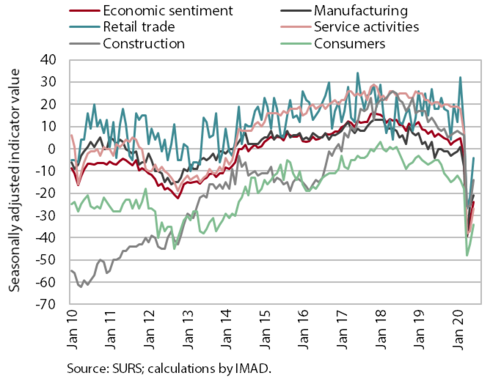
In June, economic sentiment improved for the second month in a row but remained considerably below the level at the beginning of the year. Because of the spread of the epidemic, confidence indicators deteriorated substantially in April in all sectors. Confidence dropped the most in service activities and retail trade. Consumer confidence also fell, to its lowest level since the first measurement in 2005. In May and June, confidence indicator values rose in all activities (particularly in retail trade) but remained markedly lower than at the beginning of the year.
Traffic of electronically tolled vehicles on Slovenian motorways, June 2020
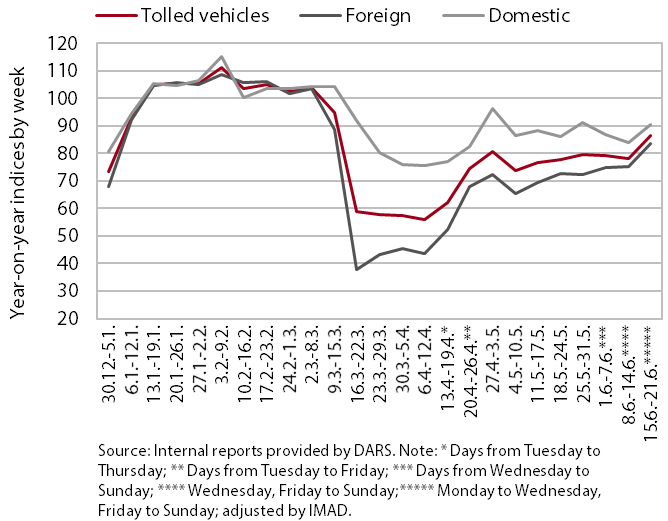
In the third week of June, freight traffic on Slovenian motorways remained significantly lower than before the epidemic, despite an increase. A more than 40% decline in the weeks after the declaration of the epidemic was followed by an improvement in April and stagnation in May. In the second half of June, traffic increased again and was around 15% lower year on year. The distance travelled by domestic and foreign trucks declined by 9% and 16% respectively. Foreign truck traffic has otherwise increased more from the lowest March value than traffic by domestic trucks, which is attributable to EU measures for the free flow of goods across borders and the general relaxation of measures in some countries.
Electricity consumption, June 2020
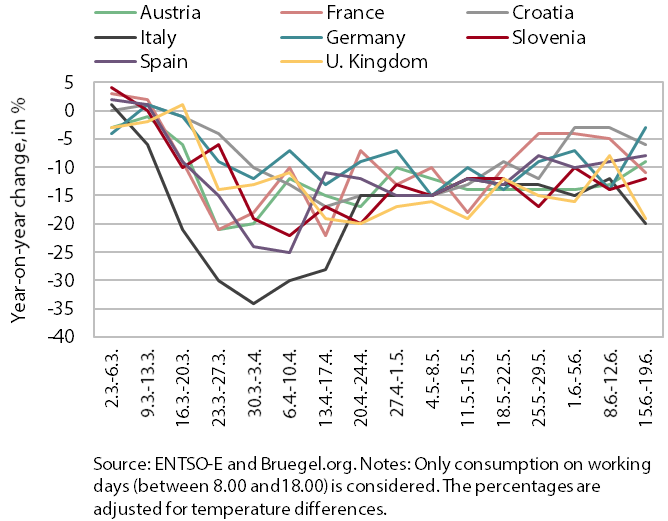
The year-on-year decline in weekly electricity consumption remained close to the May average in the third week of June. Electricity consumption, which is one of the indicators of economic activity, was 12% lower year on year in the third week of June, which is close to the average in May, when the decline was 14%. In the majority of Slovenia’s trading partners, in the third week of June the year-on-year decline in consumption deepened relative to the first half of the month. The exception is Germany, where it decreased notably, from 10% in the first half of June to 3%.
Registered unemployment, April – June 2020
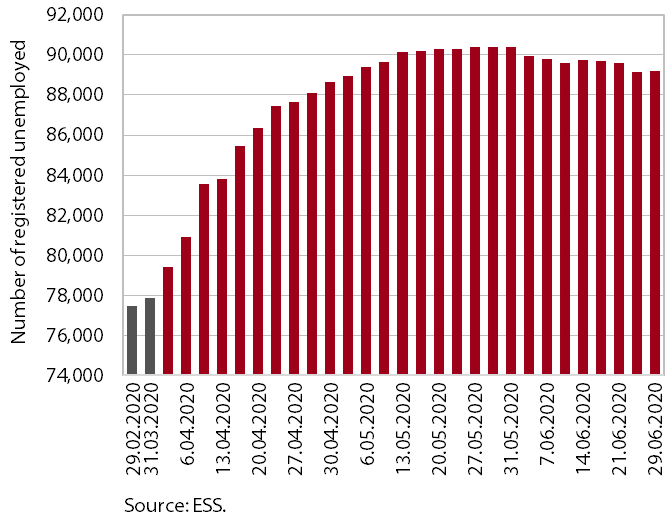
In June, the number of registered unemployed persons declined somewhat after increasing by one quarter during the epidemic. With a smaller inflow into unemployment and a larger outflow into employment, the number of unemployed persons stopped growing in the second half of May. In June, it started to fall, which is related to the lifting of stringent containment measures in Slovenia and neighbouring countries and the adoption of the third legislative package of measures to mitigate the economic impact of the crisis. By the end of May, the number of unemployed persons had risen to 90,415, which is 25.6% more than one year earlier. On 29 June, it amounted to 89,182 according to ESS unofficial (daily) data, which is 1.4% less than at the end of May. Among the newly registered, there were significantly more persons who lost work because their fixed-term employment contracts were not extended (a reason more frequently cited among younger age groups) or for business reasons than before the outbreak of the epidemic. The activities with the largest inflow are accommodation and food service activities, trade and manufacturing.
Consumer prices, May 2020
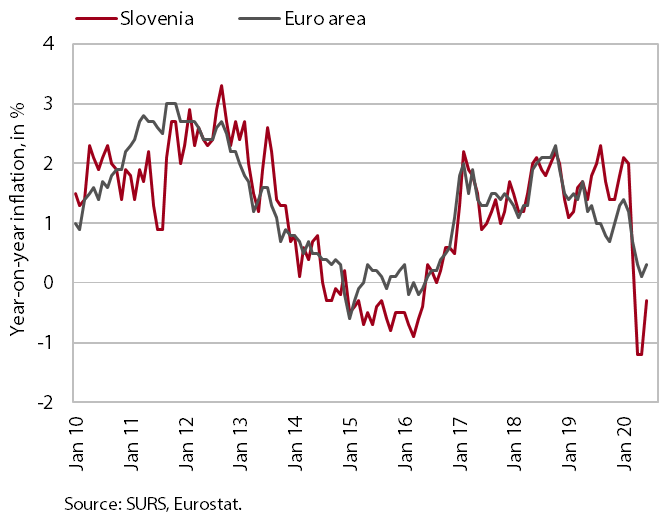
Consumer prices remained down year on year in June, but their decline was significantly less pronounced than in previous months. Electricity prices returned to the pre-epidemic level due to the expiry of the government measure on temporary non-payment of contributions related to electricity use. Lower energy prices otherwise still made the largest contribution to deflation (-1.2 pps), as prices of oil products were more than 20% lower year on year. We estimate that without the counter-cyclical adjustment of excise duties, the negative contribution of energy prices to year-on-year inflation would be approximately 0.1 pps smaller. Prices of semi-durable and durable goods remain down year on year. Growth in food prices moderated somewhat in June, while growth in prices of services remained around 2%; this was to a great extent due to strong price rises in housing-related services.
Trade, April 2020
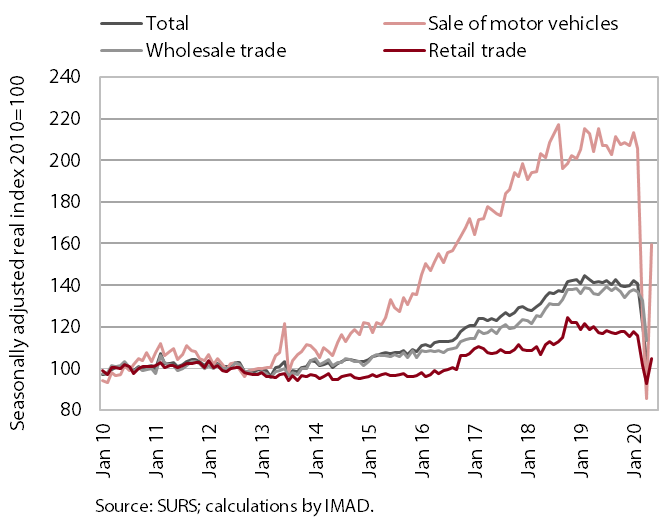
In April, turnover in trade dropped further, but provisional data for May indicate improvement in some sectors. Year on year, turnover was 27.1% lower in real terms in April. As in March, the largest monthly decline was recorded for motor vehicle sales. Due to lower activity in related sectors, turnover also fell more notably in wholesale trade. In retail trade, automotive fuel sales declined sharply again due to the measures to contain the virus and lower freight traffic. The sale of non-food products declined further. The sale of food products also dropped after two months of growth. According to provisional data, turnover in trade strengthened again in May with the reopening of shops (at the end of April or the beginning of May), but remained lower year on year in most sectors for which data are available.
Market services, April 2020
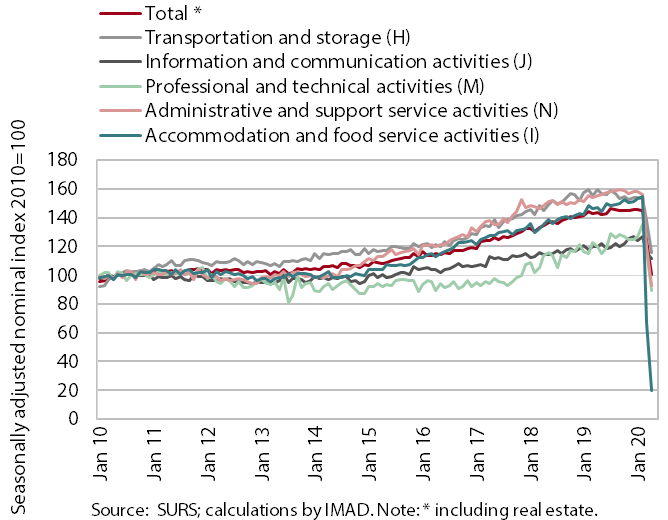
In most market services the decline in turnover deepened in April. With the closure of all hotels and restaurants (except food delivery), it deepened the most in accommodation and food service activities. Travel agencies were also strongly affected by the epidemic. Together with employment agencies, they contributed to a similar turnover decline in administrative and support service activities as in March. With a further fall in turnover in architectural and engineering services, the decline also deepened in professional and technical activities. Similarly, turnover also fell in transportation, mainly due to the shutdown of public passenger transport. Turnover dropped the least in information and communication activities, which we estimate is mainly related to sales on the domestic market.
Real estate, Q1 2020
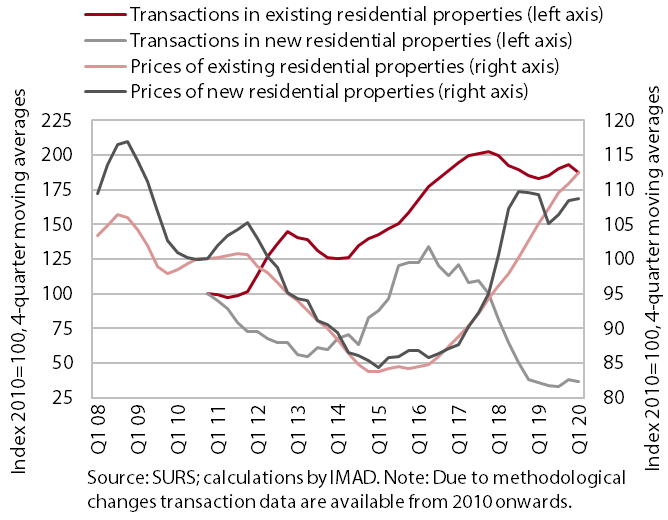
In the first quarter, residential property prices rose again, while the number of transactions decreased amid limited supply and restrictions to business activity due to outbreak of the epidemic. After 7.0% growth in 2019 as a whole, prices were up 5.5% year on year in the first quarter of 2020. The increase was largely due to higher prices of existing dwellings (up 5.7%), whose sales were otherwise the lowest in the last five years. Prices for newly built dwellings were also somewhat higher year on year, but the number of transactions in these dwellings was less than 3% of all transactions (76).
